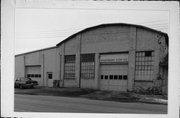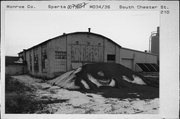| Additional Information: | Large multipaned windows; wood service door; brick applied pilasters shed roofed addition on south side. This utilitarian brick industrial building features an arched roof supported by iron trusses, a concrete floor and plain elevations devoid of historic ornament. It was constructed was part of the Sparta Iron Works complex between 1915 and 1920. This building originally was used by the Sparta Iron Works as its assembly plant when the company expanded in its operation in the 1920s. It was reused as a steam aundry after the company disbanded in the late 1920s.
The sparta Iron Works was established in 1869 when L.M. Newbury purchased the burnt out remains of the Lowrie, Irwin and Gilbert Foundry. New buildings, according to the Sparta Tax Records, for the foundry were constructed on the corner of East Oak and South Chester beginning in 1872.
The Sparta Iron Works was sold to Robert Canfield and J. Durant in 1897. This company was in operation until the late 1920s.
The Sparta Iron Works Assembly Plant is significant under Criterion C as an example of an early 20th century utilitarian industrial building. This early industrial building, constructed using modern iron and onccrete construction methods, is one of the very few well-preserved historic industrial buildings remaining in Sparta. The only other well-preserved examples of 19th and early 20th century industrial buildings identified in the 1989-1990 survey of Sparta are the accompanying buildings in the Sparta Iron Works including the machine shop (MO34/23) and the moulding room (MO34/21) building, the office and storage building (MO34/22) and the Heinz Salting Station at 300 Milwaukee Street (MO31/22-24).
The Assembly Department of the Sparta Iron Works was completed in 1915 to 1920, and was added on to in 1902, and again in 1911-1912.
The Sparta Iron Works began in 1867. Sparta's second foundry was built by Lowrie, Irwin and Gillette on East Oak Street. This foundry was purchased by the Sparta Manufacturing Company, but it thereafter the foundry was damaged heavily in a fire. In 1872, L.M. Newbury and J.P. Ward purchased what was left of the charred remains of the foundry and began the Sparta Iron Works. IN 1872 they rebuilt the main building of the foundry on the southwest corner of East Oak Street and Chester streets. Subsequently, many other buildings were added over time. In the 1870's, this foundry did an annual net business of $20,000, most of it from well-drilling machinery for digging artesian wells. In 1888, the Spart Iron Works advertised that it manufactured iron and brass castings, rotary saw mills, shingle mills, and boilers. In December, 1893, it was turned into a stock company and incorporated as Spart Iron Works Company. The officers of the company were L.M. Newbury, J.U. Durant, and C.M. Newbury. By 1894, the plant occupied two acres of land with a foundry. machine shop, planing mill, pattern shop, pattern house, blacksmith shop, engine room, paint room and storage house. At this time, the Company employed 25 hands, and it was well-equipped, including a steam hammer weighing over 11,000 pounds. Later, the operation passed to Carl Newburg and T.N. Durant, and then even later Robert and Lee Canfield assumed control over the business.
By 1900, the Sparta Iron Works continued as a foundry and machine shop, but the foundry casting business had dropped off. In 1900, they continued to make special lines of well-drilling apparatus and furnaces, as well as engines, boilers, and all kinds of agricultural machinery, employing 40 men in the works and five traveling salesmen. In 1910, Samuel Kent Dickinson assumed the management of the business, which did a large amount of work during World War I. The Assembly Department was erected during this time. However, sometime after 1922, the business was discontinued.
The Sparta Assembly Department Building gains local historical significance under Criterion A in association with the Primary Metal Processing and Metal Products Industries topic of the Industry Theme. The Sparta Iron Works was a major contributor to the growth and economy of Sparta in the nineteenth and early twentieth centuries, serving the community and the region at large with their metal products. The building's period of historical signifiacnce ranges from its erection ca. 1915 to 1920 to the closing of the foundry sometime after 1922. |
|---|
| Bibliographic References: | (A) Sanborn-Perris Insurance Maps 1889, 1894, 1900, 1911, 1922, 1931.
(B) City of Sparta Property Tax Rolls, 1870-1940.
(C) Map of Sparta, Wisconsin. Milwaukee: Phoenix Map Company of Milwaukee, 1875.
(D) Sparta Herald May 11, 1869; Jan. 5 1897; March 6, 1894.
(E) Barney, Tyler Davis, "A History of the Growth of Sparta, Wisconsin, 1850 to 1890." B.A. Thesis, University of Wisconsin, 1922, pp. 31b and 36.
(F) "History of Sparta," installment 31.
(G) Koehler, Lyle P., From Frontier Settlement to Self-Consciuos American Community: A History of One Rural Village (Sparta, Wisconsin) in the Nineteenth Century. Evansville, Indiana: Unigraphic, Inc., 1977, p. 43.
(H) No Author, History of Northern Wisconsin: Containing an Account of its Settlement, Growth, Development and Resources, An Extensive Sketch of its Counties, Cities, Towns and Villages...etc. Chicago: The Western Historical Company, 1881. p. 634.
(I) Richards, Randolph A., History of Monroe County, Wiisconsin: Past and Present, Including an Account of the Cities, Towns and Villages of the County. Chicago: C.F. Cooper & Co., 1912, pp. 273 and 323-324.
(J) Ellsworth, C.S., Views in and around Sparta, Giving a Brief History of the City and Setting Forth its Advantages for Maunfacturing and as a Place of Residence, Together with some Account of its Celebrated Magnetic Mineral Water. Portage, Wisconsin: Register Printing Co., 1933, p. 87.
(K) Gregory, John G., West Central Wisconsin: A History, vol. 4, Indianapolis: S.J. Clarke Publishing Co., 1933, p. 87.
(L) Jones, Id Lucille, "A History of Sparta, Wisconsin." B.A. Thesis, University of Wisconsin, 1915, p. 5.
(M) City of Wisconsin Tax Records, 1868-1930.
(N) Wisconsin State Gazetteer and Business Directory, Chicago: R.L. Polk, 1876, 1879, 1888, 1894, 1895-6, 1905-6, 1915, 1919). |
|---|


